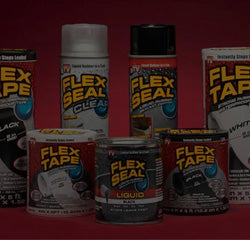What’s Your Flood Risk?
This blog was written by Flex Seal in collaboration with Flex Seal Ambassadors Dr. Reed Timmer and Mark Simpson. Images courtesy of Shutterstock.
Floods are America’s most frequent and costly disaster, causing billions of dollars in damages each year.

“Flooding is by far the worst natural disaster in terms of economic loss,” says Extreme Meteorologist and Storm Chaser, Dr. Reed Timmer. “Costs from Flood Damage in the United States have averaged a staggering $2.4 billion per year over the last decade.”

Even though damaging floods are occurring all over the country, many US residents are unaware of their flood risk. Are you one of them? Keep reading to learn where floods are likely to occur and how to find out if you’re at risk for experiencing flooding.
How To Determine Your Flood Risk

Floods can cause extensive damage to your property, so it’s essential to know your level of risk.
“A great first step to understanding the potential for flooding where you live is to check a flood risk map,” said Mark Simpson, Extreme Scientist and Storm Chaser. “Flood maps have flood zones that show the flood risk for every property. All you have to do is put in your address and you’ll be able to see what zone your home or business is in.”
These flood zones are a tool to understand your potential risk of a flooding event. In addition to flood risk maps, there are some other helpful resources to consider when it comes to assessing your flood risk.
“Looking at satellite imagery, topography, and your proximity to strongly sloping surfaces can help you better evaluate your flood risk,” says Timmer. “If you live below a hill or mountain, near wildfire burn scars, or along a coastal area, you could be at a greater risk for experiencing a flood.”
Flooding Can Happen Virtually Anywhere

It’s important to note that no matter your risk level, flooding can occur just about anywhere and at any time of the year.
“At the end of the day, you can still get some quite extreme flooding events just from a simple thunderstorm, even in low-risk areas,” Simpson says. “I live on a very steep hill, and about ten years ago, a thunderstorm caused a flood near my home. Cars were floating down the hill and bumping into each other on the way down.”

While living in a lower-risk area may lessen your chances of experiencing a flood, the potential for flooding still exists and should be taken seriously.
Be Proactive

Once you are aware of your flood risk, knowing how to prepare for a flood is a key next step.
“It’s important to be proactive when it comes to flooding. You don’t want to wait until the last minute to try and do something,” stresses Timmer. “Local news and weather alerts can let you know when conditions are favorable for flooding, which should prompt you to take action in advance, when possible.”
Although you may not be able to prepare for all flooding events, such as flash floods, which can come at a moment’s notice, there are many other situations that you may be able to prepare for ahead of time.
A great way to make those preparations is to utilize Flex Seal Flood Protection products. This new innovation in flood protection is specifically designed to help prevent damaging flood waters from entering your home or business. These UL-verified* products work together to create multiple layers of waterproof protection and can be used to seal up windows, doors, vents, or anywhere water may enter.
Keep in mind that every structure is different, making it impossible to stop all floodwaters every single time, but our Flood Protection products can help slow or even stop water from entering your home or business and can be removed once the storm has passed.**
Knowing your flood risk and keeping Flex Seal Flood Protection products on hand can help you be as ready as possible in case flooding strikes.

IMPORTANT INFORMATION: Always follow state and local warnings regarding evacuations. Never seal people or animals inside of a structure. Every structure is different, so it's impossible to stop all flood waters 100% of the time. Depending on the age and type of construction, there may be areas that cannot be seen or sealed. Unsealed porous surfaces, such as concrete, can seep water during extended underwater exposure. Not intended for flash floods. Patent Pending.
* The Flex Flood Protection line has been evaluated by UL Solutions and meets applicable verification requirements for stopping water intrusion for the specified gap widths, water depths, specified gap widths and water depths as described here. These tests were performed in a UL Solutions laboratory using manufacturer’s recommended application instructions.
** May leave residue or remove paint. Refer to FlexSealProducts.com/flood for removal instructions.











































